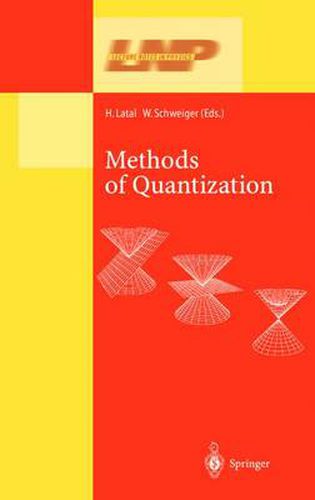Readings Newsletter
Become a Readings Member to make your shopping experience even easier.
Sign in or sign up for free!
You’re not far away from qualifying for FREE standard shipping within Australia
You’ve qualified for FREE standard shipping within Australia
The cart is loading…






This title is printed to order. This book may have been self-published. If so, we cannot guarantee the quality of the content. In the main most books will have gone through the editing process however some may not. We therefore suggest that you be aware of this before ordering this book. If in doubt check either the author or publisher’s details as we are unable to accept any returns unless they are faulty. Please contact us if you have any questions.
Thisvolumecontainsthewrittenversionsofinvitedlecturespresentedat the 39. InternationaleUniversitatswochenfur .. Kern-undTeilchenphysik in Schladming, Austria, which took place from February 26th to March 4th, 2000. The title of the school was Methods of Quantization . This is, of course,averybroad?eld,soonlysomeofthenewandinterestingdevel- mentscouldbecoveredwithinthescopeoftheschool. About75yearsagoSchrodingerpresentedhisfamouswaveequationand Heisenbergcameupwithhisalgebraicapproachtothequantum-theoretical treatmentofatoms. Aimingmainlyatanappropriatedescriptionofatomic systems, these original developments did not take into consideration E- stein'stheoryofspecialrelativity. WiththeworkofDirac,Heisenberg,and Pauliitsoonbecameobviousthatauni?edtreatmentofrelativisticandqu- tume?ectsisachievedbymeansoflocalquantum?eldtheory,i. e. anintrinsic many-particletheory. Mostofourpresentunderstandingoftheelementary buildingblocksofmatterandtheforcesbetweenthemisbasedonthequ- tizedversionof?eldtheorieswhicharelocallysymmetricundergaugetra- formations. Nowadays,theprevailingtoolsforquantum-?eldtheoreticalc- culationsarecovariantperturbationtheoryandfunctional-integralmethods. Beingnotmanifestlycovariant,theHamiltonianapproachtoquantum-?eld theorieslagssomewhatbehind,althoughitresemblesverymuchthefamiliar nonrelativisticquantummechanicsofpointparticles. Aparticularlyintere- ingHamiltonianformulationofquantum-?eldtheoriesisobtainedbyqu- tizingthe?eldsonhypersurfacesoftheMinkowsispacewhicharetangential tothelightcone. The timeevolution ofthesystemisthenconsideredin + light-conetime x =t+z/c. Theappealingfeaturesof light-conequ- tization ,whicharethereasonsfortherenewedinterestinthisformulation ofquantum?eldtheories,werehighlightedinthelecturesofBernardBakker andThomasHeinzl. Oneoftheopenproblemsoflight-conequantizationis theissueofspontaneoussymmetrybreaking. Thiscanbetracedbacktozero modeswhich,ingeneral,aresubjecttocomplicatedconstraintequations. A generalformalismforthequantizationofphysicalsystemswithconstraints waspresentedbyJohnKlauder. Theperturbativede?nitionofquantum?eld theoriesisingenerala?ictedbysingularitieswhichareovercomebyare- larizationandrenormalizationprocedure. Structuralaspectsoftherenormal- VI Preface izationprobleminthecaseofgaugeinvariant?eldtheorieswerediscussed inthelectureofKlausSibold. Areviewofthemathematicsunderlyingthe functional-integralquantizationwasgivenbyLudwigStreit. Apartfromthetopicsincludedinthisvolumetherewerealsolectures ontheKaluza-odingerpresentedhisfamouswaveequationand Heisenbergcameupwithhisalgebraicapproachtothequantum-theoretical treatmentofatoms. Aimingmainlyatanappropriatedescriptionofatomic systems, these original developments did not take into consideration E- stein'stheoryofspecialrelativity. WiththeworkofDirac,Heisenberg,and Pauliitsoonbecameobviousthatauni?edtreatmentofrelativisticandqu- tume?ectsisachievedbymeansoflocalquantum?eldtheory,i. e. anintrinsic many-particletheory. Mostofourpresentunderstandingoftheelementary buildingblocksofmatterandtheforcesbetweenthemisbasedonthequ- tizedversionof?eldtheorieswhicharelocallysymmetricundergaugetra- formations. Nowadays,theprevailingtoolsforquantum-?eldtheoreticalc- culationsarecovariantperturbationtheoryandfunctional-integralmethods. Beingnotmanifestlycovariant,theHamiltonianapproachtoquantum-?eld theorieslagssomewhatbehind,althoughitresemblesverymuchthefamiliar nonrelativisticquantummechanicsofpointparticles. Aparticularlyintere- ingHamiltonianformulationofquantum-?eldtheoriesisobtainedbyqu- tizingthe? eldsonhypersurfacesoftheMinkowsispacewhicharetangential tothelightcone. The timeevolution ofthesystemisthenconsideredin + light-conetime x =t+z/c. Theappealingfeaturesof light-conequ- tization ,whicharethereasonsfortherenewedinterestinthisformulation ofquantum?eldtheories,werehighlightedinthelecturesofBernardBakker andThomasHeinzl. Oneoftheopenproblemsoflight-conequantizationis theissueofspontaneoussymmetrybreaking. Thiscanbetracedbacktozero modeswhich,ingeneral,aresubjecttocomplicatedconstraintequations. A generalformalismforthequantizationofphysicalsystemswithconstraints waspresentedbyJohnKlauder. Theperturbativede?nitionofquantum?eld theoriesisingenerala?ictedbysingularitieswhichareovercomebyare- larizationandrenormalizationprocedure. Structuralaspectsoftherenormal- VI Preface izationprobleminthecaseofgaugeinvariant?eldtheorieswerediscussed inthelectureofKlausSibold. Areviewofthemathematicsunderlyingthe functional-integralquantizationwasgivenbyLudwigStreit. Apartfromthetopicsincludedinthisvolumetherewerealsolectures ontheKaluza-Kleinprogramforsupergravity(P. vanNieuwenhuizen),on dynamicalr-matricesandquantization(A. Alekseev),andonthequantum Liouvillemodelasaninstructiveexampleofquantumintegrablemodels(L. Faddeev). Inaddition,theschoolwascomplementedbymanyexcellents- inars. Thelistofseminarspeakersandthetopicsaddressedbythemcanbe foundattheendofthisvolume. Theinterestedreaderisrequestedtocontact thespeakersdirectlyfordetailedinformationorpertinentmaterial. Finally,wewouldliketoexpressourgratitudetothelecturersforalltheir e?ortsandtothemainsponsorsoftheschool,theAustrianMinistryofE- cation,Science,andCultureandtheGovernmentofStyria,forprovidingg- eroussupport. Wealsoappreciatethevaluableorganizationalandtechnical assistanceofthetownofSchladming,theSteyr-Daimler-PuchFahrzeugte- nik, Ricoh Austria, Styria Online, and the Hornig company. Furthermore, wethankoursecretaries,S. FuchsandE. Monschein,anumberofgra- atestudentsfromourinstitute,and,lastbutnotleast,ourcolleaguesfrom theorganizingcommitteefortheirassistanceinpreparingandrunningthe school. Graz, HeimoLatal March2001 WolfgangSchweiger Contents FormsofRelativisticDynamics BernardL. G. Bakker…1 1 Introduction…1 2 ThePoincar'eGroup…3 3 FormsofRelativisticDynamics…4 3. 1 ComparisonofInstantForm,FrontForm,andPointForm…6 4 Light-FrontDynamics…9 4. 1 RelativeMomentum,InvariantMass…9 4. 2 TheBoxDiagram…14 5 Poincar'eGeneratorsinFieldTheory…19 5. 1 FermionsInteractingwithaScalarField…20 5. 2 InstantForm…20 5. 3 FrontForm(LF)…21 5. 4 InteractingandNon-interactingGeneratorsonanInstant andontheLightFront…22 6 Light-FrontPerturbationTheory…23 6. 1 ConnectionofCovariantAmplitudes toLight-FrontAmplitudes…24 6. 2 Regularization…26 6. 3 MinusRegularization…26 7 TriangleDiagraminYukawaTheory…27 7. 1 CovariantCalculation …28 7. 2 ConstructionoftheCurrentinLFD…30 7. 3 NumericalResults…37 3 8 FourVariationsonaThemein? Theory…37 8. 1 CovariantCalculation…39 8. 2 Instant-FormCalculation…42 8. 3 CalculationinLight-FrontCoordinates…47 8. 4 Front-FormCalculation…49 9 DimensionalRegularization:BasicFormulae…51 10 Four-DimensionalIntegration…52 11 SomeUsefulIntegrals…53 References…53 VIII Contents Light-ConeQuantization:FoundationsandApplications ThomasHeinzl…
$9.00 standard shipping within Australia
FREE standard shipping within Australia for orders over $100.00
Express & International shipping calculated at checkout
This title is printed to order. This book may have been self-published. If so, we cannot guarantee the quality of the content. In the main most books will have gone through the editing process however some may not. We therefore suggest that you be aware of this before ordering this book. If in doubt check either the author or publisher’s details as we are unable to accept any returns unless they are faulty. Please contact us if you have any questions.
Thisvolumecontainsthewrittenversionsofinvitedlecturespresentedat the 39. InternationaleUniversitatswochenfur .. Kern-undTeilchenphysik in Schladming, Austria, which took place from February 26th to March 4th, 2000. The title of the school was Methods of Quantization . This is, of course,averybroad?eld,soonlysomeofthenewandinterestingdevel- mentscouldbecoveredwithinthescopeoftheschool. About75yearsagoSchrodingerpresentedhisfamouswaveequationand Heisenbergcameupwithhisalgebraicapproachtothequantum-theoretical treatmentofatoms. Aimingmainlyatanappropriatedescriptionofatomic systems, these original developments did not take into consideration E- stein'stheoryofspecialrelativity. WiththeworkofDirac,Heisenberg,and Pauliitsoonbecameobviousthatauni?edtreatmentofrelativisticandqu- tume?ectsisachievedbymeansoflocalquantum?eldtheory,i. e. anintrinsic many-particletheory. Mostofourpresentunderstandingoftheelementary buildingblocksofmatterandtheforcesbetweenthemisbasedonthequ- tizedversionof?eldtheorieswhicharelocallysymmetricundergaugetra- formations. Nowadays,theprevailingtoolsforquantum-?eldtheoreticalc- culationsarecovariantperturbationtheoryandfunctional-integralmethods. Beingnotmanifestlycovariant,theHamiltonianapproachtoquantum-?eld theorieslagssomewhatbehind,althoughitresemblesverymuchthefamiliar nonrelativisticquantummechanicsofpointparticles. Aparticularlyintere- ingHamiltonianformulationofquantum-?eldtheoriesisobtainedbyqu- tizingthe?eldsonhypersurfacesoftheMinkowsispacewhicharetangential tothelightcone. The timeevolution ofthesystemisthenconsideredin + light-conetime x =t+z/c. Theappealingfeaturesof light-conequ- tization ,whicharethereasonsfortherenewedinterestinthisformulation ofquantum?eldtheories,werehighlightedinthelecturesofBernardBakker andThomasHeinzl. Oneoftheopenproblemsoflight-conequantizationis theissueofspontaneoussymmetrybreaking. Thiscanbetracedbacktozero modeswhich,ingeneral,aresubjecttocomplicatedconstraintequations. A generalformalismforthequantizationofphysicalsystemswithconstraints waspresentedbyJohnKlauder. Theperturbativede?nitionofquantum?eld theoriesisingenerala?ictedbysingularitieswhichareovercomebyare- larizationandrenormalizationprocedure. Structuralaspectsoftherenormal- VI Preface izationprobleminthecaseofgaugeinvariant?eldtheorieswerediscussed inthelectureofKlausSibold. Areviewofthemathematicsunderlyingthe functional-integralquantizationwasgivenbyLudwigStreit. Apartfromthetopicsincludedinthisvolumetherewerealsolectures ontheKaluza-odingerpresentedhisfamouswaveequationand Heisenbergcameupwithhisalgebraicapproachtothequantum-theoretical treatmentofatoms. Aimingmainlyatanappropriatedescriptionofatomic systems, these original developments did not take into consideration E- stein'stheoryofspecialrelativity. WiththeworkofDirac,Heisenberg,and Pauliitsoonbecameobviousthatauni?edtreatmentofrelativisticandqu- tume?ectsisachievedbymeansoflocalquantum?eldtheory,i. e. anintrinsic many-particletheory. Mostofourpresentunderstandingoftheelementary buildingblocksofmatterandtheforcesbetweenthemisbasedonthequ- tizedversionof?eldtheorieswhicharelocallysymmetricundergaugetra- formations. Nowadays,theprevailingtoolsforquantum-?eldtheoreticalc- culationsarecovariantperturbationtheoryandfunctional-integralmethods. Beingnotmanifestlycovariant,theHamiltonianapproachtoquantum-?eld theorieslagssomewhatbehind,althoughitresemblesverymuchthefamiliar nonrelativisticquantummechanicsofpointparticles. Aparticularlyintere- ingHamiltonianformulationofquantum-?eldtheoriesisobtainedbyqu- tizingthe? eldsonhypersurfacesoftheMinkowsispacewhicharetangential tothelightcone. The timeevolution ofthesystemisthenconsideredin + light-conetime x =t+z/c. Theappealingfeaturesof light-conequ- tization ,whicharethereasonsfortherenewedinterestinthisformulation ofquantum?eldtheories,werehighlightedinthelecturesofBernardBakker andThomasHeinzl. Oneoftheopenproblemsoflight-conequantizationis theissueofspontaneoussymmetrybreaking. Thiscanbetracedbacktozero modeswhich,ingeneral,aresubjecttocomplicatedconstraintequations. A generalformalismforthequantizationofphysicalsystemswithconstraints waspresentedbyJohnKlauder. Theperturbativede?nitionofquantum?eld theoriesisingenerala?ictedbysingularitieswhichareovercomebyare- larizationandrenormalizationprocedure. Structuralaspectsoftherenormal- VI Preface izationprobleminthecaseofgaugeinvariant?eldtheorieswerediscussed inthelectureofKlausSibold. Areviewofthemathematicsunderlyingthe functional-integralquantizationwasgivenbyLudwigStreit. Apartfromthetopicsincludedinthisvolumetherewerealsolectures ontheKaluza-Kleinprogramforsupergravity(P. vanNieuwenhuizen),on dynamicalr-matricesandquantization(A. Alekseev),andonthequantum Liouvillemodelasaninstructiveexampleofquantumintegrablemodels(L. Faddeev). Inaddition,theschoolwascomplementedbymanyexcellents- inars. Thelistofseminarspeakersandthetopicsaddressedbythemcanbe foundattheendofthisvolume. Theinterestedreaderisrequestedtocontact thespeakersdirectlyfordetailedinformationorpertinentmaterial. Finally,wewouldliketoexpressourgratitudetothelecturersforalltheir e?ortsandtothemainsponsorsoftheschool,theAustrianMinistryofE- cation,Science,andCultureandtheGovernmentofStyria,forprovidingg- eroussupport. Wealsoappreciatethevaluableorganizationalandtechnical assistanceofthetownofSchladming,theSteyr-Daimler-PuchFahrzeugte- nik, Ricoh Austria, Styria Online, and the Hornig company. Furthermore, wethankoursecretaries,S. FuchsandE. Monschein,anumberofgra- atestudentsfromourinstitute,and,lastbutnotleast,ourcolleaguesfrom theorganizingcommitteefortheirassistanceinpreparingandrunningthe school. Graz, HeimoLatal March2001 WolfgangSchweiger Contents FormsofRelativisticDynamics BernardL. G. Bakker…1 1 Introduction…1 2 ThePoincar'eGroup…3 3 FormsofRelativisticDynamics…4 3. 1 ComparisonofInstantForm,FrontForm,andPointForm…6 4 Light-FrontDynamics…9 4. 1 RelativeMomentum,InvariantMass…9 4. 2 TheBoxDiagram…14 5 Poincar'eGeneratorsinFieldTheory…19 5. 1 FermionsInteractingwithaScalarField…20 5. 2 InstantForm…20 5. 3 FrontForm(LF)…21 5. 4 InteractingandNon-interactingGeneratorsonanInstant andontheLightFront…22 6 Light-FrontPerturbationTheory…23 6. 1 ConnectionofCovariantAmplitudes toLight-FrontAmplitudes…24 6. 2 Regularization…26 6. 3 MinusRegularization…26 7 TriangleDiagraminYukawaTheory…27 7. 1 CovariantCalculation …28 7. 2 ConstructionoftheCurrentinLFD…30 7. 3 NumericalResults…37 3 8 FourVariationsonaThemein? Theory…37 8. 1 CovariantCalculation…39 8. 2 Instant-FormCalculation…42 8. 3 CalculationinLight-FrontCoordinates…47 8. 4 Front-FormCalculation…49 9 DimensionalRegularization:BasicFormulae…51 10 Four-DimensionalIntegration…52 11 SomeUsefulIntegrals…53 References…53 VIII Contents Light-ConeQuantization:FoundationsandApplications ThomasHeinzl…